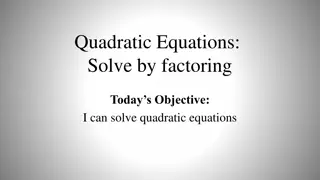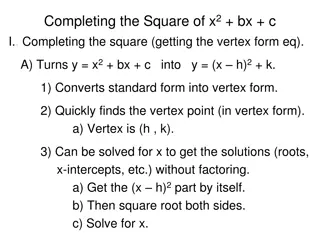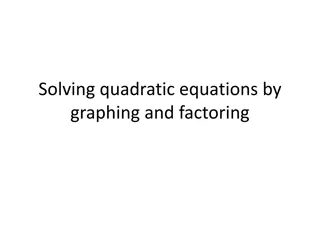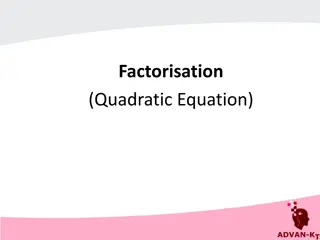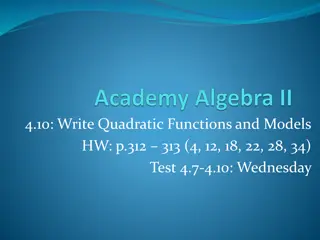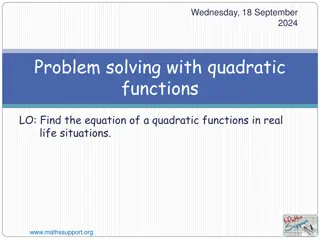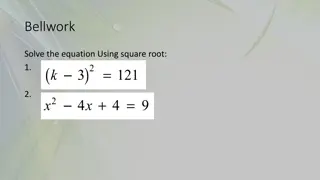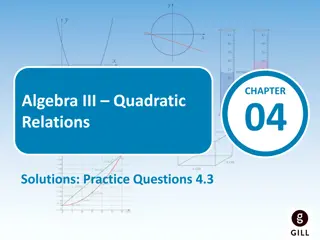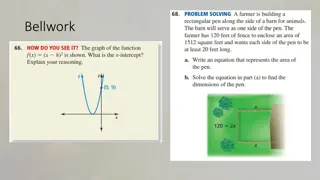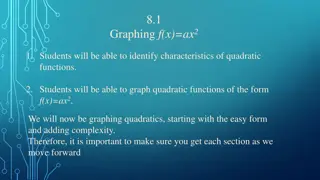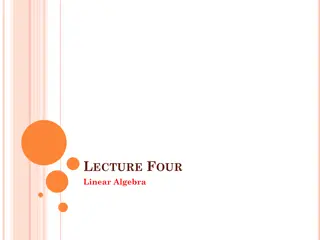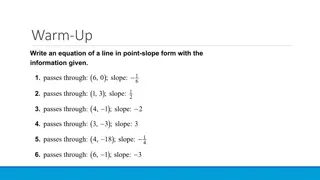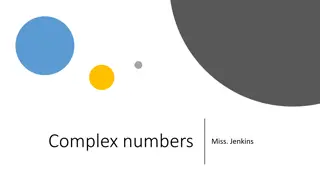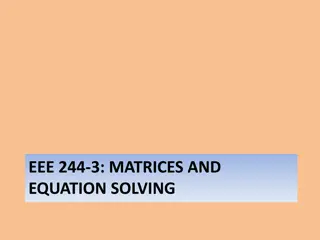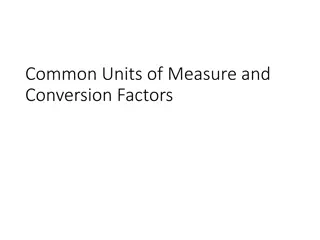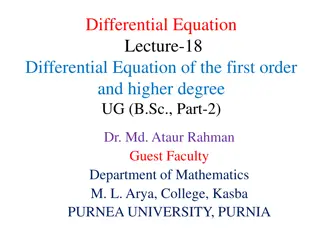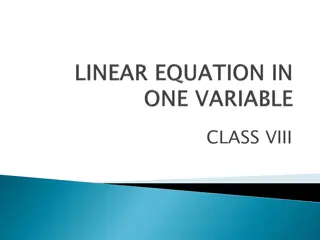Solving Quadratic Equations by Completing the Square
Learn how to solve quadratic equations using the method of completing the square. This method is useful for equations that cannot be easily solved by factorization. Understand the steps involved, such as identifying perfect square trinomials, factorizing, taking square roots, and rearranging to find exact solutions in surd form. Practice examples provided for better understanding.
Download Presentation

Please find below an Image/Link to download the presentation.
The content on the website is provided AS IS for your information and personal use only. It may not be sold, licensed, or shared on other websites without obtaining consent from the author. Download presentation by click this link. If you encounter any issues during the download, it is possible that the publisher has removed the file from their server.
E N D
Presentation Transcript
12 September 2024 Solving quadratic equations (by completing the square) LO: To solve quadratic equations by completing the square. www.mathssupport.org www.mathssupport.org
Starter Solve these quadratic equations by factorisation: x = 3 x = 4 x = 5 =(x + 3)(x + 3) =(x + 3)2 =(x + 4)(x + 4) =(x + 4)2 =(x + 5)(x + 5) =(x + 5)2 =(x 6)(x 6) =(x 6)2 x2 + 6x + 9 = 0 x2 + 8x + 16 = 0 x2 + 10x + 25 = 0 x2 12x + 36 = 0 x2 14x + 49 = 0 x2 18x + 81 = 0 x = 6 x = 7 x = 9 =(x 7)(x 7) =(x 7)2 =(x 9)(x 9) =(x 9)2 www.mathssupport.org www.mathssupport.org
Solving quadratics by completing the square Some Quadratic equations cannot be solved by factorization. There are other methods to solve quadratic equation without using the GDC For example, the quadratic equation, x2 + 10x + 25 = 3 () If we collect all the terms on one side of the equation, we get x2 + 10x + 22 = 0 Which does not factorise easily, so we can use a different method (x + 5)2 = 3 x + 5 = 3 Factorising the perfect square trinomial: Taking the square root of both sides: x = 5 3 Rearranging for x: or x = 5 + 3 x = 5 x has two solutions 3 This method is called completing the square www.mathssupport.org www.mathssupport.org
Solving quadratics by completing the square Solve the quadratic equation, x2 14x + 49 = 6 () We can see easily that in the left hand side we have a perfect square trinomial We are going to use the method Completing the square Factorising the perfect square trinomial: Taking the square root of both sides: (x 7)2 = 6 x 7 = 6 Rearranging for x: x = 7 6 x has two solutions x = 7 + 6or x = 7 6 Giving the answers in surd form gives the exact solutions www.mathssupport.org www.mathssupport.org
Solving quadratics by completing the square Solve the quadratic equation, x2 + 6x = 5 6 We can see that in the left hand side we do not have a perfect square trinomial but we can make it. Which number is needed to have a perfect square trinomial on the left hand side? Halve the coefficient of x = 3 Square it = 9 If we add 9 in both sides the equation does not change x2 + 6x + 9 = 5 + 9 And we have a perfect square trinomial on the left x2 + 6x + 9 = 14 (x + 3)2 = 14 x + 3 = 14 Factorising the perfect square trinomial: Taking the square root of both sides: Rearranging for x: x has two solutions x = 3 14 x = 3 + 14 or x = 3 14 Giving the answers in surd form gives the exact solutions www.mathssupport.org www.mathssupport.org
Solving quadratics by completing the square Solve the quadratic equation, x2 12x = 5 12 We can see that in the left hand side we do not have a perfect square trinomial but we can make it. Which number is needed to have a perfect square trinomial on the left hand side? Halve the coefficient of x = 6 Square it = 36 If we add 36 in both sides the equation does not change x2 12x + 36 = 5 + 36 And we have a perfect square trinomial on the left x2 12x + 36 = 41 (x 6)2 = 41 x 6 = 41 Factorising the perfect square trinomial: Taking the square root of both sides: Rearranging for x: x has two solutions Giving the answers in surd form gives the exact solutions x = 6 41 x = 6 + 41 or x = 6 41 www.mathssupport.org www.mathssupport.org
Solving quadratics by completing the square Solve the quadratic equation, x2 + 8x + 5 = 0 Rearranging to leave all the terms with x on the left-hand side, x2 + 8x = 5 Completing the square on the left-hand side, x2 + 8x + 16 = 5 + 16 Halve the coefficient of x, square it and add to both sides x2 + 8x + 16 = 11 (x + 4)2 = 11 x + 4 = 11 Factorising the perfect square trinomial: square root both sides: Rearranging for x: x = 4 11 x = 4 + 11 or x = 4 11 www.mathssupport.org www.mathssupport.org
Solving quadratics by completing the square x2 + 3x 2 = 0 Solve the quadratic equation, Rearranging to leave all the terms with x on the left-hand side, x2 + 3x = 2 Completing the square on the left-hand side, Which number is needed to have a perfect square trinomial on the left hand side? Halve the coefficient of x= If we add in both sides the equation does not change ? ? ? ? ? ? ? ? ? Square it = ?? ? ? ? ? x2 + 3x + = x2 + 3x + = 2 + And we have a perfect square trinomial on the left 2 ? +3 ? +3 =17 Factorising the perfect square trinomial: 2 4 2= 17 ? = 3 17 square root both sides: 2 Rearranging for x: 2 ? = 3 17 ? = 3 + 17 or 2 2 www.mathssupport.org www.mathssupport.org
Solving quadratics by completing the square In order to complete the square, the coefficient of the x2 term must be 1 If the x2 term has a coefficient other than 1, before completing the square, you can divide through by the coefficient, or factor out the coefficient. Solve the equation 2x2 12x + 4 = 0 We can complete the square for 2x2 12x + 4 by first dividing both sides of the equation by the coefficient of x2, which is 2 x2 6x + 2 = 0 Rearranging to leave all the terms with x on the left-hand side: x2 6x = 2 x2 6x + 9 = 2 + 9 x2 6x + 9 = 7 (x 3)2 = 7 x 3 = 7 Completing the square on the left-hand side: Factorising the perfect square trinomial: square root both sides: x = 3 7 Rearranging for x: x = 3 + 7 or x = 3 7 www.mathssupport.org www.mathssupport.org
Solving quadratics by completing the square Solve the equation 3x2 18x = 2 We can complete the square for 3x2 18x = 2 by first factorise the left-hand side of the equation 3(x2 6x) = 2 x2 6x = 2 3 3 + 9 3 3 Rearranging to leave all the terms with x on the left-hand side: Completing the square on the left-hand side: x2 6x + 9 = 2 x2 6x + 9 = 29 (x 3)2 = 29 Factorising the perfect square trinomial: x 3 = 29 3 square root both sides: x = 3 29 3 Rearranging for x: x =? ?? This answer can also be written as ? www.mathssupport.org www.mathssupport.org
Solving quadratics by completing the square Solve the equation 2x2 4x + 1 = 0 by completing the square. Write the answer to 3 decimal places. 2x2 4x + 1 = 0 2x2 4x = 1 2(x2 2x) = 1 x2 2x = 1 x2 2x + 1 = 1 Rearranging to leave all the terms with x on the left-hand side: factorise the left-hand side divide both sides by 2: 2 completing the square: 2+ 1 (x 1)2 = 1 Factorising the perfect square in the left-hand side: 2 1 2 x 1 = square root both sides: 1 2 or 1 2 x = 1 + x = 1 x = 1.707 x = 0.293 (to 3 d. p) www.mathssupport.org www.mathssupport.org
Thank you for using resources from A close up of a cage Description automatically generated For more resources visit our website https://www.mathssupport.org If you have a special request, drop us an email info@mathssupport.org www.mathssupport.org www.mathssupport.org


